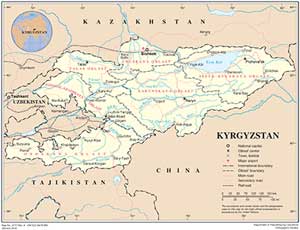U.S. stays in Kyrgyzstan as
Pentagon extends air base lease
PART 1
By
Heather Cottin
Published Jul 8, 2009 1:37 PM
By increasing its financial offer to the regime in Kyrgyzstan, the Pentagon has
been able to buy the rights to extend its lease on Manas air base. More than
189,000 U.S. and NATO troops and much war materiel have been flown the 600
miles from this base to Kabul and the killing fields of Afghanistan.
Kyrgyzstan, a country about half the size of California with a population of
5.4 million, is located in Central Asia on the northwest border of China. It
experienced one of the “color revolutions” that broke socialist
republics away from the Soviet Union and whittled down Yugoslavia.
In February Kyrgyz President Kurmanbek Bakiyev had signed a decree ordering
U.S. troops to leave Manas. It cost Washington hundreds of millions of dollars
to change his mind.
The first “color revolution” took place in 2000 in the former
Yugoslavia, after the U.S. and its NATO allies broke up the former socialist
federation and rained bombs for 78 days on Serbia in the spring of 1999. In
2000, an uprising led by the OTPOR group in Serbia invalidated the democratic
election of Slobodan Milosevic, claiming vote fraud.
During the election, the U.S. National Endowment for Democracy funded Serbian
groups that opposed President Slobodan Milosevic while billionaire George
Soros’ Open Society Institute helped organize and fund the opposition.
Serbia—which still had remnants of socialism—was transformed into a
pro-NATO capitalist mini-state, open to Western investment and penetration.
U.S. quasi-governmental institutions like the International Crisis Group and
Radio Free Europe, both funded by Soros, as well as the National Endowment for
Democracy helped bring about Georgia’s “Rose Revolution” in
2003, Ukraine’s “Orange Revolution” in 2004 and
Kyrgyzstan’s “Tulip Revolution” in 2005.
These countries had all split from the Soviet Union in 1991 and had already
begun pro-capitalist reforms but were not complete tools of the imperialist
West. In each case, the U.S. government, with corporate financing, helped put
in place a regime even more open to privatization and foreign investment. This
extended the reach of the Pentagon and/or NATO further east toward Russia and
China. By this year, NATO had grown from its origin as a U.S.-Western Europe
military pact to having 28 members, mostly former socialist countries or Soviet
republics.
Poverty accompanies neo-liberalism
In all the former socialist countries, poverty and unemployment grew
astronomically as their “color revolution” governments carried out
economic “shock therapy” as ordered by the International Monetary
Fund. State industries were either shut down or privatized and social services
cut, while Western corporations introduced factories that paid abysmally low
wages even as they closed higher-wage factories at home.
In Kyrgyzstan the U.S. had backed Bakiyev for president. But once in office, he
needed money and bargained for a better deal from the U.S. or Russia, both of
which sought political, economic and military ties with this former Soviet
republic.
On a trip to Moscow in February Bakiyev managed to procure a $2 billion loan,
which included money to help Kyrgyzstan build the 1,900-megawatt Karambata 1
hydroelectric project. (Mosnews, June 19) In June, Russia’s state-owned
natural gas giant Gazprom agreed to purchase the majority share of the state
gas enterprise Kyrgyzgaz. (UPI, June 19)
The Shanghai Cooperation Organization is an international mutual-security group
originally founded as the Shanghai Five in 1996 by the governments of China,
Kazakhstan, Kyrgyzstan, Russia and Tajikistan and renamed the SCO in 2001 after
the admission of Uzbekistan.
The SCO met in June in Yekaterinburg, Russia, along with leaders of other
developing Eurasian nations to discuss the increasingly tense situation in the
region. Washington, as the most powerful member of NATO, is heavily
militarizing its new NATO client states, from Georgia to Poland, while leaning
on its NATO allies to contribute more troops to the war against
Afghanistan.
Bakiyev had sworn he was closing the Manas base in Kyrgyzstan, but met with
Afghanistan’s president Hamid Karzai in Yekatarinburg and subsequently
changed his tune.
The payoff
Turkish President Abdullah Gul was also in Yekatarinburg and told Bakiyev that
if the United States was able to continue to use the airbase at Manas,
Kyrgyzstan could expect a billion dollars in U.S. investment. (Nezavisimaya
Gazeta)
Sweetening the package, the Pentagon agreed to a rise in the rent it pays for
the use of the base from $17 million to $60 million a year.
In addition, the U.S. government indicated it would pay the Kyrgyz government
about $120 million for development, construction, airport traffic control and
its “counter-terrorism” and anti-drug trafficking efforts. (Russia
Today, June 23)
Toktogul Kakchekeev, an independent Kyrgyz political scientist and security
expert, says that “The Americans have accomplished their main
task—they have retained their presence within the Commonwealth of
Independent States,” referring to the euphemistically named alliance of
former USSR republics. He adds that “the airbase case has been played
according to a thoroughly worked-out scenario. [The] unwillingness of the
Pentagon to leave Kyrgyzstan demonstrates intention to retain its presence in
CIS, particularly in Central Asia.” (Asia News, June 24)
The money from the U.S. is unlikely to alleviate the poverty of the majority in
Kyrgyzstan. The government has been condemned both within and outside Kyrgyz
borders as one of the most corrupt in the world.
Articles copyright 1995-2012 Workers World.
Verbatim copying and distribution of this entire article is permitted in any medium without royalty provided this notice is preserved.
Workers World, 55 W. 17 St., NY, NY 10011
Email:
[email protected]
Subscribe
[email protected]
Support independent news
DONATE


